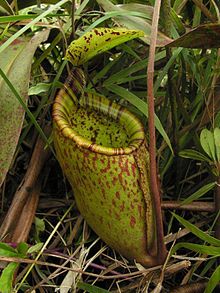| Nepenthes palawanensis | |
|---|---|

| |
| A lower pitcher of N. palawanensis photographed by Stewart McPherson | |
| Scientific classification | |
| Kingdom: | Plantae |
| Clade: | Tracheophytes |
| Clade: | Angiosperms |
| Clade: | Eudicots |
| Order: | Caryophyllales |
| Family: | Nepenthaceae |
| Genus: | Nepenthes |
| Species: | N. palawanensis
|
| Binomial name | |
| Nepenthes palawanensis | |
Nepenthes palawanensis is a tropical pitcher plant endemic to Sultan Peak on the island of Palawan in the Philippines, where it grows at elevations of 1,100–1,236 m (3,609–4,055 ft) above sea level.[2] It was discovered in February 2010 by Jehson Cervancia and Stewart McPherson.[3]
The species appears to be most closely related to N. attenboroughii, which grows on nearby Mount Victoria.[3][4] Nepenthes palawanensis can be distinguished from N. attenboroughii by its pitchers, which are even larger, sometimes exceeding 35 cm in height,[5] and with a capacity of 1.5–2 litres (0.33–0.44 imp gal; 0.40–0.53 US gal) of water.[6] (The largest pitchers remain those of N. rajah.)[6] Another difference from N. attenboroughii is that the pitchers of N. palawanensis are lined with orange to red hairs.[6]
Nepenthes palawanensis was featured as number 4 on Chris Packham's "top ten discoveries of extraordinary and weird new species from the last decade" on the BBC programme Decade of Discovery, first broadcast on December 14, 2010.[7][8]
The discovery of N. attenboroughii, by a team that included McPherson, helped to obtain local support for the protection of the Mount Victoria range; following the discovery of N. palawanensis, it was hoped that similar support for the Sultan range might result.[6] To date, neither mountain has been afforded protected status.[9]
Nepenthes palawanensis forms natural hybrids with a taxon resembling N. philippinensis.[10]
References[edit]
- ^ Clarke, C.M.; Lee, C. (2014). "Nepenthes palawanensis". IUCN Red List of Threatened Species. 2014: e.T48995172A49009815. doi:10.2305/IUCN.UK.2014-1.RLTS.T48995172A49009815.en. Retrieved 19 November 2021.
- ^ a b McPherson, S., J. Cervancia, C. Lee, M. Jaunzems, A. Fleischmann, F. Mey, E. Gironella & A. Robinson 2010. Nepenthes palawanensis (Nepenthaceae), a new pitcher plant species from Sultan Peak, Palawan Island, Philippines. In: S.R. McPherson Carnivorous Plants and their Habitats. Volume 2. Redfern Natural History Productions, Poole. pp. 1332–1339.
- ^ a b New Species - Nepenthes palawanensis Archived 2011-07-15 at the Wayback Machine. Redfern Natural History Productions Ltd.
- ^ McPherson, S. 2010. New giant Nepenthes species - Nepenthes palawanensis. Carnivorous Plants UK, February 28, 2010.
- ^ McPherson, S. 2010. Nepenthes palawanensis: another new species of giant pitcher plant from the Philippines. Carnivorous Plant Newsletter 39(3): 89–90.
- ^ a b c d [Anonymous] 2010. Pitcher this: a new Nepenthes. The Plantsman (New Series) 9(2): 73.
- ^ Decade of Discovery. BBC iPlayer. [N. palawanensis segment runs from approximately 35:07 to 36:43]
- ^ The decade's top ten new species. BBC Earth News, December 12, 2010.
- ^ The Protected Areas of Palawan. Palawan Council for Sustainable Development.
- ^ McPherson, S.R. & V.B. Amoroso 2011. Field Guide to the Pitcher Plants of the Philippines. Redfern Natural History Productions, Poole.
- Co, L. & W. Suarez 2012. Nepenthaceae. Co's Digital Flora of the Philippines.
- Guerini, M. 2011. "2010: new species of Carnivorous Plants" (PDF). Associazione Italiana Piante Carnivore.
- McPherson, S., G. Bourke, J. Cervancia, M. Jaunzems, E. Gironella, A. Robinson & A. Fleischmann 2011. Nepenthes leonardoi (Nepenthaceae), a new pitcher plant species from Palawan, Philippines. Carniflora Australis 8(1): 4–19.
- Exploration of Mount Anipahan and Mount Kiamo. [video] Redfern Natural History Productions.
- Lecture on Plant Hunting – Royal Horticultural Society 6th May 2014. [video] Redfern Natural History Productions.

Well, that’s interesting to know that Psilotum nudum are known as whisk ferns. Psilotum nudum is the commoner species of the two. While the P. flaccidum is a rare species and is found in the tropical islands. Both the species are usually epiphytic in habit and grow upon tree ferns. These species may also be terrestrial and grow in humus or in the crevices of the rocks.
View the detailed Guide of Psilotum nudum: Detailed Study Of Psilotum Nudum (Whisk Fern), Classification, Anatomy, Reproduction